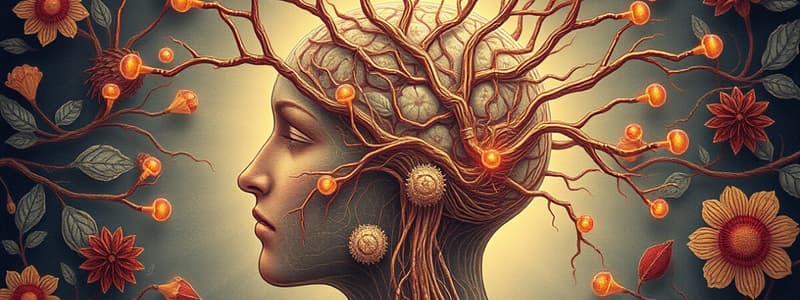Podcast
Questions and Answers
What is the nervous system?
What is the nervous system?
- The body's speedy communication network (correct)
- The system that regulates breathing
- The skeletal muscle system
- The system that controls emotions
What is the peripheral nervous system?
What is the peripheral nervous system?
The sensory and motor neurons that connect the central nervous system to the rest of the body.
What makes up the central nervous system?
What makes up the central nervous system?
The brain and spinal cord.
What is the function of the autonomic nervous system?
What is the function of the autonomic nervous system?
What does the somatic nervous system control?
What does the somatic nervous system control?
What is the role of the sympathetic nervous system?
What is the role of the sympathetic nervous system?
What does the parasympathetic nervous system do?
What does the parasympathetic nervous system do?
Flashcards are hidden until you start studying
Study Notes
Nervous System Overview
- The nervous system is a complex communication network in the body, allowing for rapid responses and coordination of activities.
- It comprises all nerve cells within both the peripheral and central systems.
Peripheral Nervous System (PNS)
- The PNS consists of sensory and motor neurons, linking the central nervous system to the body's extremities and organs.
- It facilitates communication between the brain/spinal cord and the rest of the body.
Central Nervous System (CNS)
- The CNS is made up solely of the brain and spinal cord, serving as the main processing center for information and decision-making.
Autonomic Nervous System (ANS)
- Part of the PNS, the ANS regulates involuntary functions such as digestion and heart rate, influencing internal organ activities.
Somatic Nervous System
- The somatic nervous system is a division of the PNS responsible for voluntary muscle movements, overseeing the body's skeletal muscles.
- Referred to as the skeletal nervous system, it enables conscious control of movement.
Sympathetic Nervous System
- This division of the ANS prepares the body for high-energy activities, triggering the fight-or-flight response.
- It mobilizes energy reserves to face perceived threats or stressors.
Parasympathetic Nervous System
- Opposite to the sympathetic system, the parasympathetic division promotes relaxation and restorative processes within the body.
- It conserves energy by slowing heart rate, enhancing digestion, and supporting other functions essential for recovery.
Studying That Suits You
Use AI to generate personalized quizzes and flashcards to suit your learning preferences.




